One year ago, we were lamenting about a sub-par winter season. We had a big December for snowfall in 2021, then a lackluster January through March in 2022. Only to get dumped on by one of the snowiest April’s on record.
This year the story was a little different, snow started falling in late October and hardly let up for the next five months. Temperatures were also much colder than normal from November all the way through March, allowing the snow to accumulate to great depths, around the valley and in the mountains.
Colder and much snowier than normal was the scene across many areas of the Western United States this winter. Here I will highlight just how cold and snowy it was here in Jackson Hole, Wyoming
Cold Town Temps
It all began back in November, when Jackson had its coldest November ever recorded, with a mean temperature for the month of 17 degrees. That was 11 degrees colder than the long-term average temperature in November and it beat the old record from 1938 by nearly two degrees.
The cold temps never let up. December 2022’s mean monthly temperature was three degrees colder than the long-term average, January 2023 was two degrees colder than average, February 2023 was eight degrees colder, and March of 2023 ended up a full nine degrees colder than the long-term average temperature for March in Jackson.
From November 1st, 2022, through March 31st. 2023 the Town of Jackson recorded 65 days with minimum temperatures of zero degrees or colder. That’s 43-percent of the days over the past 5 months that we woke up to temps at or below zero.
The coldest day of the winter was on January 31st, 2023, when the official thermometer at the Jackson Climate Station registered 33 degrees below zero. The last time it was colder than that in town was on December 23rd, 1990, when it got down to 40 below zero.
That all adds up to a ridiculously cold winter and should toss any notions about global warming out the window, at least on a local scale. The much colder than normal temperatures of the past five months only added to the trend in Jackson of colder than average annual mean temperatures that we have seen over the last 10 years now.
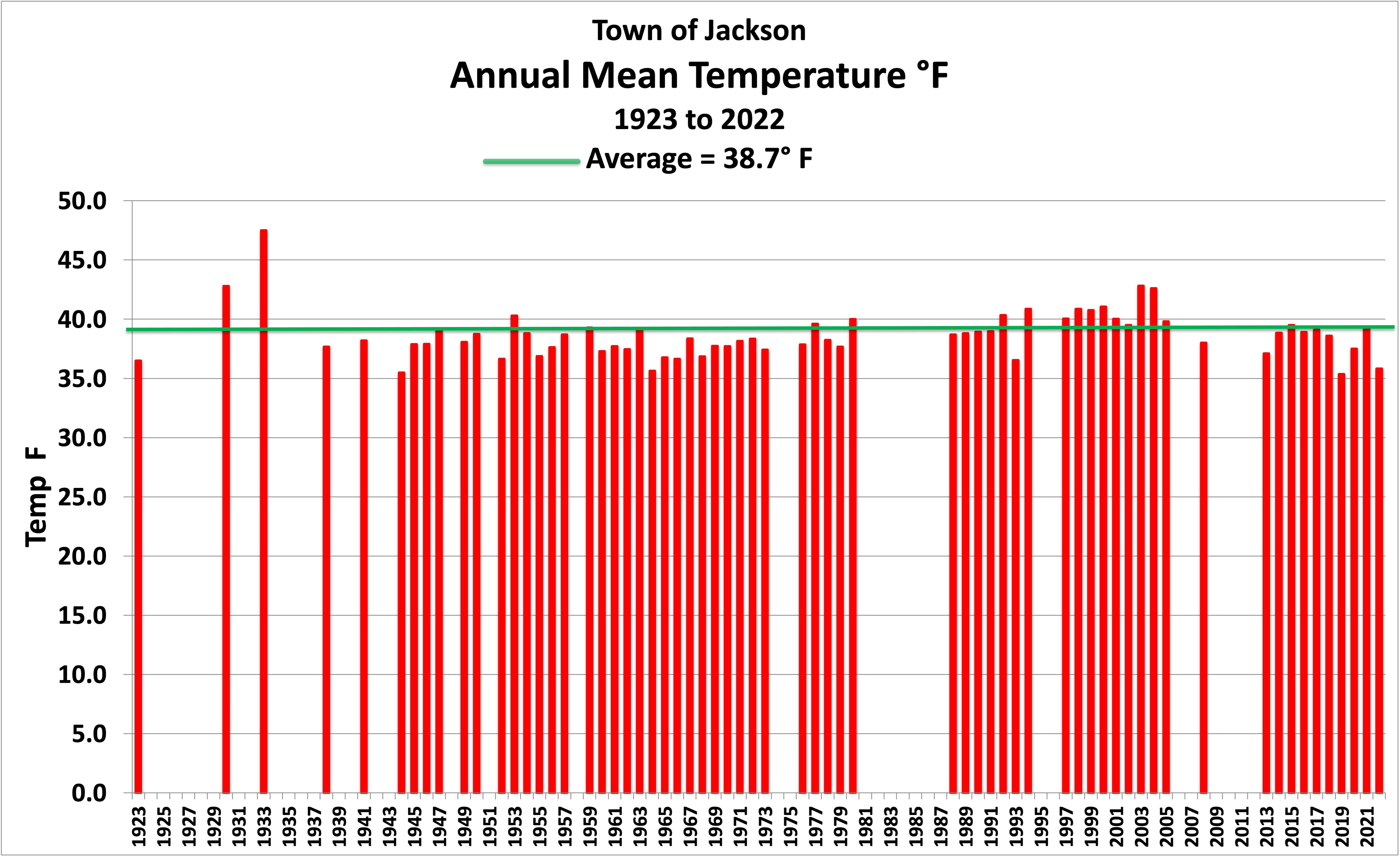
Big Town Snow
Total snowfall recorded at the Jackson Climate Station from December 1st, 2022, through March 31st, 2023, was 83 inches, compared to the average snowfall for that four-month period of 61 inches.
Last year the October through March snowfall total in town was only 56 inches. However, you may recall that April 2022 roared in with an additional 17 inches of snowfall in town, when traditionally April only averages around 4 inches of snow. April of 2022 tied for the third snowiest April on record in town.
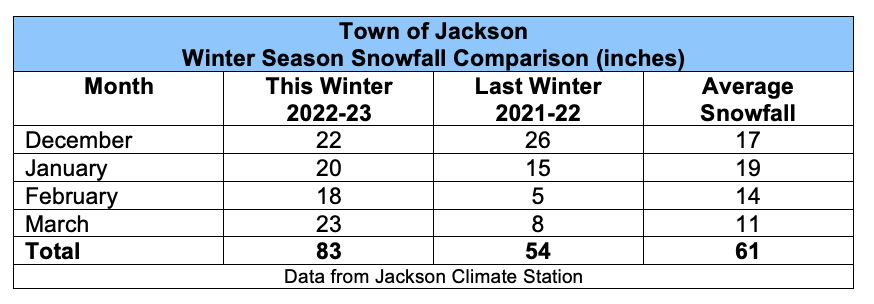
If you add the snowfall from October and November of 2022 to the total, of one inch and 21 inches, respectively, then the total snowfall from October 2022 through March 2023 comes to 105 inches. That means, if you live in town, you had to shovel, blow, or plow almost nine feet of snow out of your driveway this winter.
That entire fall and winter season snowfall total of 105 inches is 148-percent of the town’s long-term average snowfall for October through March of 71 inches.
More info about the trends of colder and snowier in Jackson can be found in my blog post: Review of the Weather in 2022
Record Town Depths
Because of the colder than normal temperatures all winter long, snow on the ground barely had any opportunity to melt and settlement of the snow pack in the valley was minimal. During the first week in April the settled snow depth in town at the climate station was at 26 inches on April 3rd. That is the deepest snow ever recorded on that date in town, breaking the record on that date of 22 inches from 1985.
On April 5th, 2023 the settled snow depth was 24 inches, breaking the old record of 18 inches from 2008. April 6th also established a new snow depth record in town. The average snow depth during the first week in April in the Town of Jackson is between 4 and 5 inches. So, if you thought there was a lot of snow on the ground for this time of year, your observation was correct.
Record Mountain Snow
At Jackson Hole Mountain Resort’s Rendezvous Bowl weather station, at around the 9,600-foot elevation, the total snowfall for what I will call the ski-season, from December 1st, 2022, to April 1st, 2023, was 443 inches. That is 143-percent of the average snowfall for that four-month period at Rendezvous Bowl, which is 309 inches.
Total snowfall during last year’s ski season was 241 inches. December 2021 alone accounted for 112 of those inches and was the only month of last winter’s ski season that had above average snowfall. April of 2022 added another 79 inches of snowfall, but most of that fell after the ski area had closed.
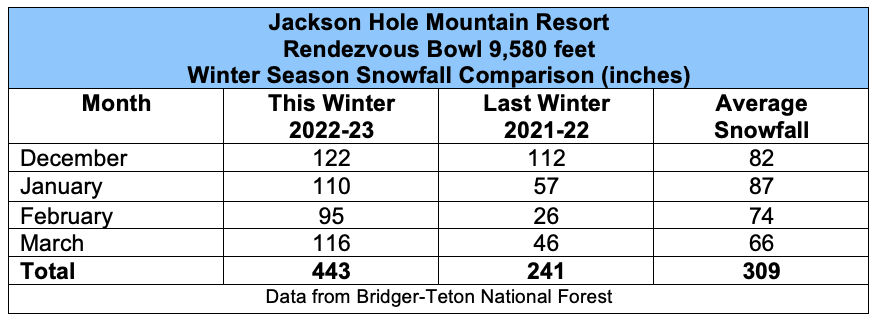
In the bigger picture, the total snowfall recorded on the mountain from October 1st, 2022, to April 1st, 2023, was 572 inches. That was only four inches shy of the record snowfall from the winter of 1996-97, which had 576 inches of snowfall during that same period. That would make the winter of 2022-23 the second snowiest ever recorded on the mountain, for total snowfall between October 1st and April 1st.
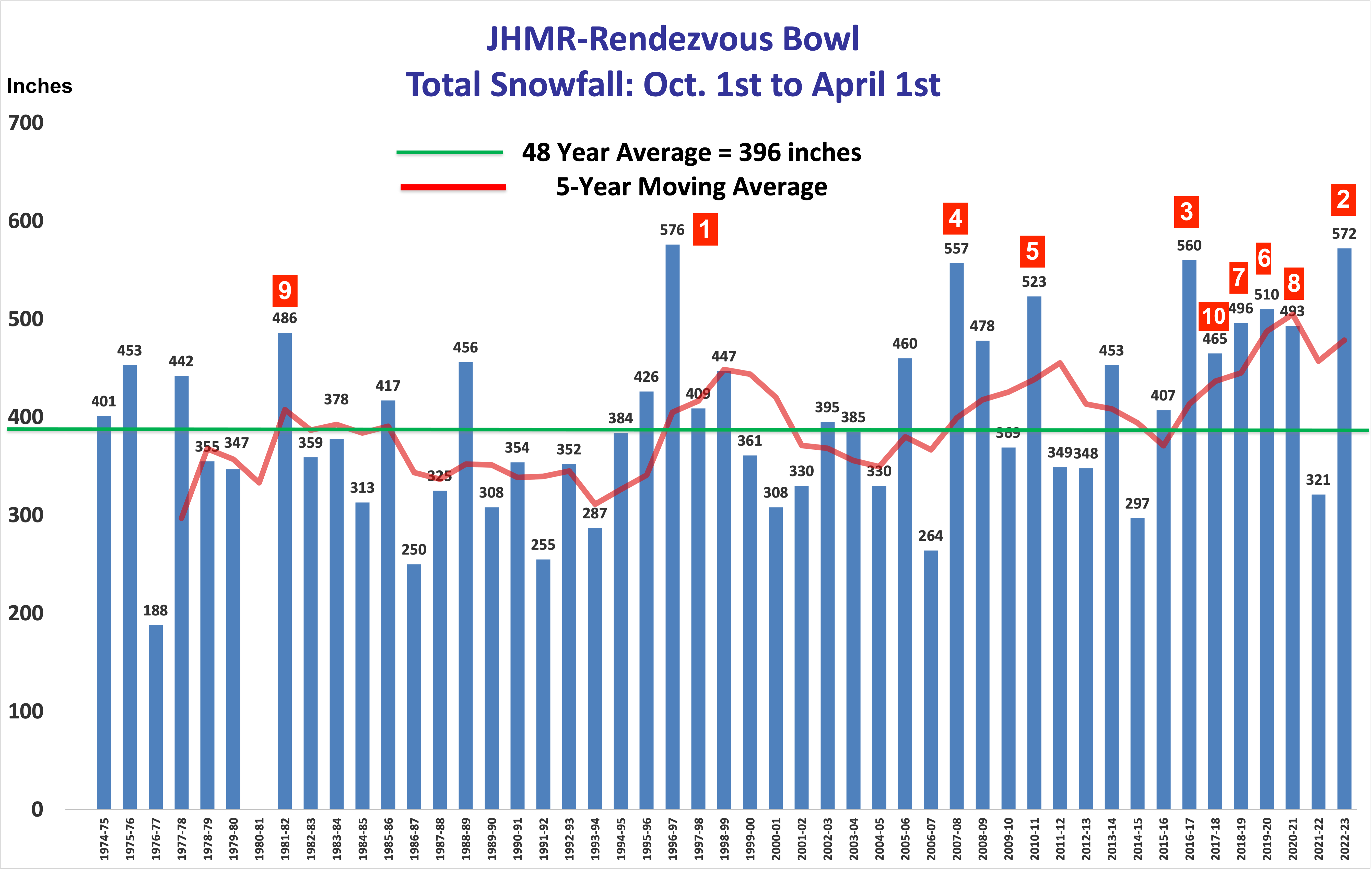
However, if you include snowfall data through closing day, then the winter of 2022-23 surpassed was the snowiest winter ever recorded on the mountain, with a grand total of 595 inches of snowfall this season. That beats the 585 inches that fell during this same time period in 1996-97 and also the 590 inches that was recorded in the winter of 2017-18 from October 1st through April 9th.
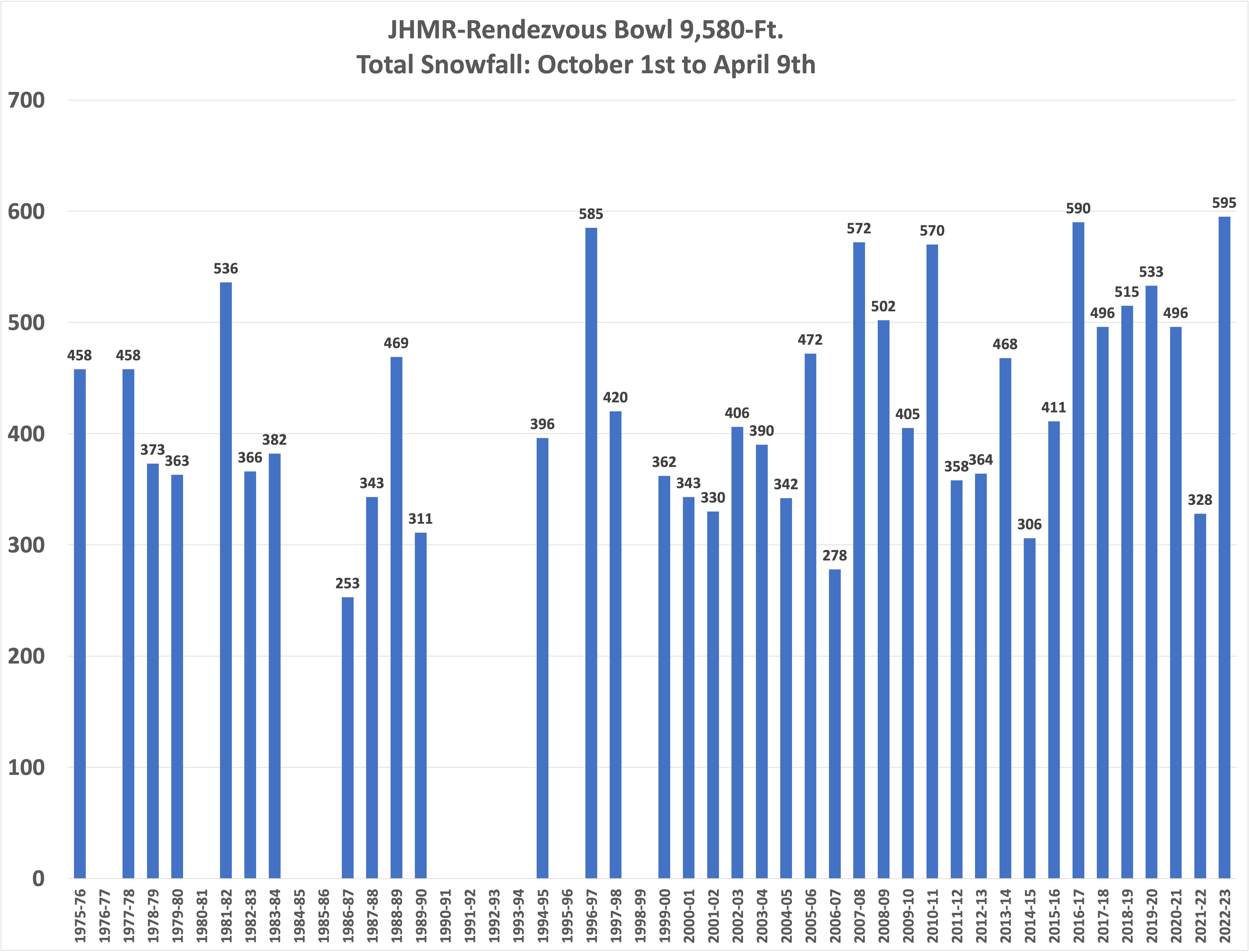
Bottom-line is, no matter how you slice it, 8 out of the top 10 snowiest winters at the Jackson Hole Mountain Resort occurred in the last 15 years. Five of those top-ten winters happened within the last six years! The winter of 2021-22 was the only year in the last six that saw below average snowfall.
Mountain Snow Depths
Once again, colder temperatures made for lower density snowfall throughout this past winter. That made for great powder skiing and provided some of the best coverage, top to bottom on the mountain, than we have seen in years, since 2010-11 at least.
When the season ended on April 9th this year, the settled snow depth in Rendezvous Bowl was at 129 inches. Last year on April 9th, 2022, it was only 73 inches deep. Ten feet vs. 6 feet of snow depth at 9600-ft. The average depth on April 9th is 106 inches. The deepest ever on that date was in 2017, with 159 inches.
What made the skiing even better was the fact that snow depths at the base of the mountain stayed deep all winter also. I skied on closing day and did not see a single rock or bare patch of ground exposed on any of the major runs. That is not the usual case in early April.
Snow depths at the base of the mountain on April 9th, 2023 stood at 37 inches. Last winter, on April 9th, 2022, the snow depth was 9 inches. The deepest ever was in 2011, with 40 inches. The average snow depth on that date at the base is 21 inches.
A Unique Winter
What made this winter so exceptional was the fact that it was consistently colder and snowier than normal for five consecutive months, which made for very consistent skiing conditions all season long. So, if you like snow, this was truly a dream winter in every meteorological sense.
And to all those climatologists who have been making the same claim now for the past 20 years that, “within a few years, we aren’t going to know what snow is”, I would say, come spend a winter in Jackson Hole.
Jim is the chief meteorologist at mountainweather.com and has been forecasting the weather in Jackson Hole and the Teton Range for over 30 years.

